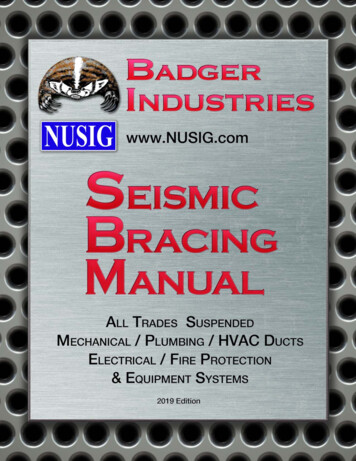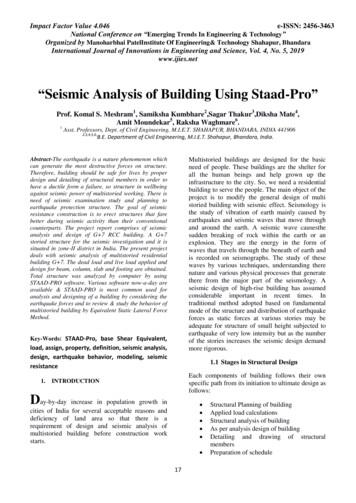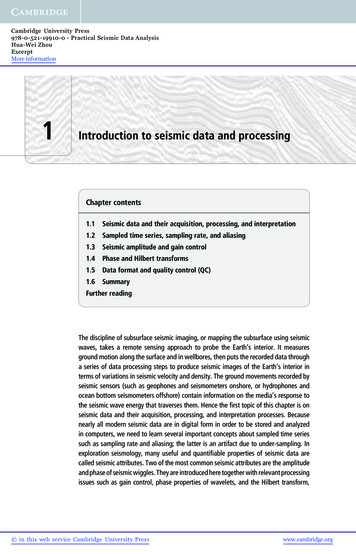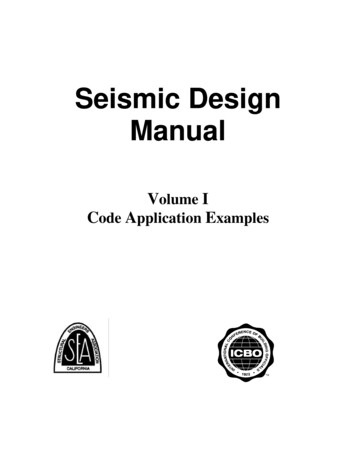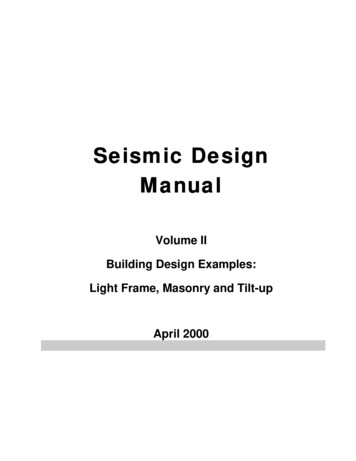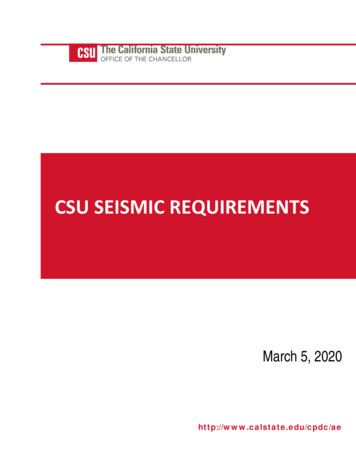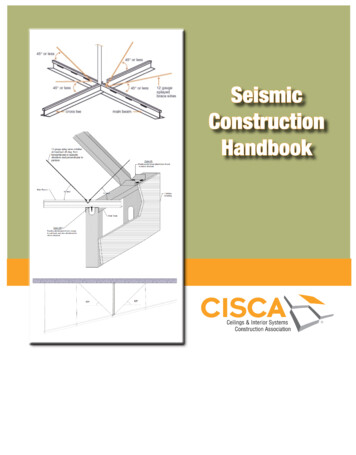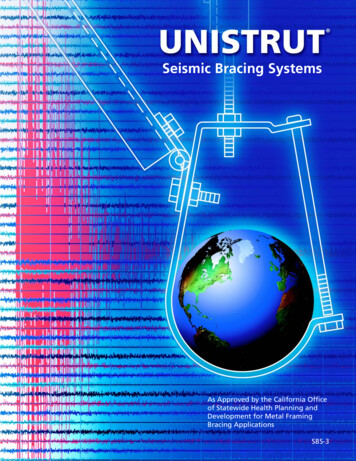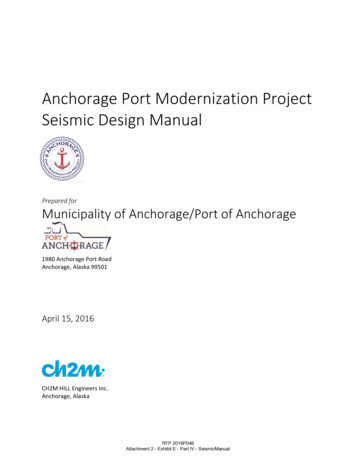
Transcription
Anchorage Port Modernization ProjectSeismic Design ManualPrepared forMunicipality of Anchorage/Port of Anchorage1980 Anchorage Port RoadAnchorage, Alaska 99501April 15, 2016CH2M HILL Engineers Inc.Anchorage, AlaskaRFP 2016P046Attachment 2 - Exhibit E - Part IV - SeismicManual
RFP 2016P046Attachment 2 - Exhibit E - Part IV - SeismicManual
dApproved0Draft for Internal Review7/21/2015HG/DGA/DRJADP1Draft for Review1/22/2016HG/DGAJADP2Final Draft3/21/2016HG/DGAJADPEN0722151040ANCIIIRFP 2016P046Attachment 2 - Exhibit E - Part IV - SeismicManual
RFP 2016P046Attachment 2 - Exhibit E - Part IV - SeismicManual
ContentsSectionPageRevisions . iiiAcronyms and Abbreviations .ix1Introduction . 1‐11.1Objective . 1‐11.2Development Background . 1‐11.2.1 History . 1‐21.2.2 Need for Modernization . 1‐21.2.3 Post‐seismic Performance Expectations . 1‐31.3Scope . 1‐31.3.1 Applicability to Port of Anchorage Facilities . 1‐41.3.2 Future Revisions. 1‐41.4Special Environmental Considerations . 1‐41.4.1 Seismic Environment . 1‐51.4.2 Geology . 1‐51.4.3 Tides, Currents, Winds, and Ice . 1‐61.4.4 Marine Mammals and Fish . 1‐61.5Use of Document . 1‐62Controlling Design Codes, Standards, and References . 2‐12.1Applicable Codes and Standards for Pile‐supported Piers and Wharves . 2‐12.2Applicable Codes and Standards for Buildings and Building‐like Structures . 2‐12.3Reference Documents . 2‐23Seismic Performance Requirements. 3‐13.1Performance Levels. 3‐13.1.1 Minimal Damage . 3‐13.1.2 Controlled and Repairable Damage . 3‐13.1.3 Life Safety Protection . 3‐13.2Seismic Hazard Levels . 3‐13.2.1 Operating Level Earthquake . 3‐23.2.2 Contingency Level Earthquake . 3‐23.2.3 Design Earthquake . 3‐23.2.4 Maximum Considered Earthquake . 3‐23.3Design Classifications and Minimum Seismic Performance Requirements . 3‐23.3.1 Design Classifications . 3‐23.3.2 Pile‐supported Wharf and Trestle Seismic Performance Requirements . 3‐33.3.3 Petroleum, Oil, and Lubricants Terminals – Additional PerformanceRequirements. 3‐33.3.4 Sheet Pile Bulkhead and Cofferdam Seismic Performance Requirements . 3‐33.4Seismic Ground Motions . 3‐43.4.1 Firm‐ground Acceleration Response Spectra . 3‐43.4.2 Firm‐ground Earthquake Time Histories. 3‐63.4.3 Small‐strain Wave Velocity Measurements . 3‐63.4.4 Dynamic Site‐Response Analysis. 3‐7EN0722151040ANCVRFP 2016P046Attachment 2 - Exhibit E - Part IV - SeismicManual
CONTENTSSectionPage4Structural Requirements . 4‐14.1Design Service Life . 4‐14.1.1 Piers, Wharves, Trestles, and Other Marine Structures . 4‐14.1.2 Buildings and Land‐based Structures. 4‐14.2Design Loads . 4‐14.2.1 Dead Loads . 4‐14.2.2 Live Loads . 4‐14.2.3 Thermal Loads . 4‐54.2.4 Shrinkage Loads . 4‐54.2.5 Creep Loads . 4‐54.2.6 Buoyancy Loads . 4‐54.2.7 Earth Pressure Load . 4‐54.2.8 Hydrostatic Loads for Cofferdams and Sheet Pile Bulkheads . 4‐54.2.9 Wind Loads . 4‐64.2.10 Current Loads . 4‐64.2.11 Wave Loads . 4‐64.2.12 Snow Loads . 4‐64.2.13 Ice Loads . 4‐64.2.14 Mooring and Breasting Loads . 4‐74.2.15 Berthing Loads . 4‐84.2.16 Earthquake Loads . 4‐94.3Load Combinations . 4‐104.3.1 Load Combinations for Pile‐supported Piers, Wharves, and Trestles . 4‐104.3.2 Load Combinations for Buildings . 4‐124.4Acceptable Method of Seismic Analysis and Design . 4‐124.4.1 Pile‐supported Piers, Wharves, and Trestles . 4‐124.4.2 Buildings . 4‐134.5Seismic Design and Analysis Requirements . 4‐134.5.1 Material Properties . 4‐134.5.2 Strain Limits . 4‐134.5.3 Section Properties . 4‐144.5.4 Seismic Mass . 4‐144.5.5 Displacement Capacity. 4‐154.5.6 Displacement Demand. 4‐164.5.7 Applicability of Modal Response Spectrum Analysis . 4‐164.5.8 Seismic P‐delta Effects . 4‐164.5.9 Design of Capacity‐protected Members and Actions . 4‐164.5.10 Batter Piles . 4‐174.5.11 Seismic Isolation Systems . 4‐174.6Design and Detailing Requirements . 4‐174.7Ancillary Components . 4‐174.8Other Design Requirements . 4‐174.8.1 Elevations . 4‐174.8.2 Dredge Depth . 4‐184.8.3 Scour . 4‐185Geotechnical Requirements for Seismic Design . 5‐15.1Loading Conditions . 5‐1VIEN0722151040ANCRFP 2016P046Attachment 2 - Exhibit E - Part IV - SeismicManual
CONTENTSSectionPage5.25.35.45.55.6Liquefaction Evaluation . 5‐15.2.1 Acceptable Methods of Analysis for Liquefaction Potential. 5‐15.2.2 Liquefaction‐induced Geologic Hazards . 5‐25.2.3 Mitigation of Liquefaction Hazards. 5‐2Seismic Effects . 5‐35.3.1 Seismic Effects due to Liquefaction . 5‐35.3.2 Seismic Effects on Nonliquefiable Soils . 5‐3Slope Stability and Lateral Ground Movements . 5‐35.4.1 Slope Stability . 5‐45.4.2 Lateral Ground Movements . 5‐4Retaining Walls, Bulkhead, and Cofferdams . 5‐55.5.1 Retaining Walls . 5‐55.5.2 Anchored Bulkhead. 5‐65.5.3 Cellular Cofferdams . 5‐6Soil‐Structure Interaction . 5‐66Other Seismic Design Requirements . 6‐16.1Tsunami . 6‐16.2Earthquake Aftershocks . 6‐16.3Earthquakes during Construction . 6‐16.4Peer Review Requirements . 6‐17References. 34‐44‐54‐64‐75‐1Minimum Seismic Performance Requirements for Pile‐supported Piers, Wharves, and TrestlesMinimum Seismic Performance Criteria for Sheet Pile Bulkhead and Cellular CofferdamsDesign Horizontal Spectral Accelerations at Selected Periods (Firm‐ground, with an Average Vs30mof 2,500 ft/s)Controlling Magnitudes and Distances for the Design EarthquakesEarthquake Time Histories to be used for Site Response AnalysisHydrostatic Water Table ElevationLoad and Resistance Factor Design Load Factors for Load CombinationsService Load Design and Allowable Stress Design Loads Factors for Load CombinationsStrain Limits for Minimal Damage Performance LevelStrain Limits for Controlled and Repairable Damage Performance LevelStrain Limits for Life Safety Protection Performance LevelTidal and Other Relevant Data at Port of AnchoragePerformance Criteria for Retaining WallsFigures3‐14‐14‐24‐34‐4Measured Small‐Strain Values of Vs (Layering is Approximate)Roll‐On and Roll‐Off Ramp Axle LoadsCrane Wheel Spacing and Load Distribution for 50‐foot‐gauge Container CraneTypical Container Handler Wheel Load ConfigurationPossible Cement Offloading Equipment ConfigurationEN0722151040ANCVIIRFP 2016P046Attachment 2 - Exhibit E - Part IV - SeismicManual
RFP 2016P046Attachment 2 - Exhibit E - Part IV - SeismicManual
Acronyms and Abbreviations less than greater than less than or equal to greater than or equal to Fdegree Fahrenheitεcextreme concrete fiber compressive strainεpstrain in prestressing tendonsεsstrain in steel pipe pile or reinforcing steel (tension of compression)εsmdstrain at peak stress of dowel reinforcementρsvolumetric ratio of confining steel1‐Done‐dimensional2‐Dtwo dimensional2/3two‐thirdsAASHTO LRFD SpecsAASHTO LRFD Bridge Design Specifications, 7th EditionAASHTO SeismicAmerican Association of State Highway and Transportation Officials GuideAASHTOAmerican Association of State Highway and Transportation OfficialsACIAmerican Concrete InstituteAISCAmerican Institute of Steel ConstructionALEaftershock level earthquakeAPI RP2ARecommended Practice for Planning, Designing, and Constructing Fixed OffshorePlatformsAPI RP2NRecommended Practice for Planning, Designing, and Constructing Structures andPipelines for Arctic ConditionsAPIAmerican Petroleum InstituteAPMPAnchorage Port Modernization ProjectARSacceleration response spectraASCEAmerican Society of Civil EngineersASCE/COPRI 61‐14 2014 American Society of Civil Engineers / Coasts, Oceans, Ports, and Rivers Institute61‐14 document, Seismic Design of Piers and WharvesASDallowable stress designASTMASTM InternationalAWSAmerican Welding SocietybblbarrelBCFBootlegger Cove FormationEN0722151040ANCIXRFP 2016P046Attachment 2 - Exhibit E - Part IV - SeismicManual
ACRONYMS AND ABBREVIATIONSbgsbelow ground surfaceCALTRANSCalifornia Department of TransportationCBCCalifornia Building CodeCH2MCH2M HILL Engineers Inc.CLEcontingency level earthquakecm/scentimeter per secondCoastal EMUSACE Engineering Manual 1110‐2‐1100, Coastal Engineering Manual, 2002COPRICoasts, Oceans, Ports, and Rivers InstituteCPTcone penetrometer testDdistanceDEdesign earthquakeDORdesigner of recordDSHAdeterministic seismic hazard analysisEHWhighest observed water elevationELWlowest observed water elevationEMEngineering ManualEPRIElectric Power Research InstituteEWeast–west directionFEMAFederal Emergency Management AgencyFHWAFederal Highway Administrationft/sfeet per secondgacceleration of gravity (g 32.2 ft/s2)GACGeotechnical Advisory CommissionGuide SpecsSpecifications for LRFD Seismic Bridge DesignIBCInternational Building CodeICCInternational Code CouncilIDidentificationISOInternational Organization for StandardizationITLInformation Technical LaboratorykkipsKIMRKitsap County Airportkipsone thousand poundsklfkips per linear footkmkilometerLMSRLarge, Medium Speed, RO‐ROXEN0722151040ANCRFP 2016P046Attachment 2 - Exhibit E - Part IV - SeismicManual
ACRONYMS AND ABBREVIATIONSLRFDload and resistance factor designmmeterMmoment magnitudem/smeter per secondMARADU.S. Maritime AdministrationMaxmaximumMCEmaximum considered earthquakeMHHWmean higher high waterMHWmean high waterMinminimumMLLWmean lower low waterMLWmean low waterMOAMunicipality of AnchorageMOTEMSMarine Oil Terminal Engineering and Maintenance Standardsmphmile per hourMSLmean sea levelMTLmean tide levelMWmagnitudeNCHRPNational Cooperative Highway Research ProgramNEHRPNational Earthquake Hazard Reduction ProgramNFPANational Fire Protection AssociationNGVD 29National Geodetic Vertical Datum of 1929NOAANational Oceanic and Atmospheric AdministrationNRCNational Research CouncilNSnorth‐south directionOLEoperating level earthquakePCEPPierce County East Precinctpcfpound per cubic footPCI Design HandbookPCI Design Handbook: Precast and Prestressed Concrete, 6th Edition, 2014PCIPrecast/Prestressed Concrete InstitutePEERPacific Earthquake Engineering ResearchPGApeak ground accelerationPIANCThe World Association for Waterborne Transport InfrastructurePIEPPort of Anchorage Intermodal Expansion ProjectPNDPND Engineers, Inc.EN0722151040ANCXIRFP 2016P046Attachment 2 - Exhibit E - Part IV - SeismicManual
ACRONYMS AND ABBREVIATIONSPOAPort of AnchoragePOLpetroleum, oil, and lubricantsPOLAPort of Los AngelesPOLBPort of Long Beachpsfpound per square footPSHAprobabilistic seismic hazard analysispsipound per square inchP‐wavecompressive waveRO‐ROroll‐on and roll‐offS1long‐period spectral accelerationSaspectral accelerationSDMSeismic Design ManualSEIStructural Engineering InstituteSFSafety FactorSLDservice load designSLRsea level riseSPTstandard penetration testSsshort‐period spectral accelerationSSIsoil‐structure interactionS‐waveshear waveTperiod of vibrationTerraconTerracon Consulting Engineers and Scientists Inc.TLlong‐period transitionU.S.United StatesUFCUnified Facilities CriteriaURSURS CorporationUSACEU.S. Army Corps of EngineersUSGSU.S. Geological SurveyVpcompressive‐wave velocityVsshear‐wave velocityWSDworking stress designXIIEN0722151040ANCRFP 2016P046Attachment 2 - Exhibit E - Part IV - SeismicManual
SECTION 1IntroductionThe Port of Anchorage (POA) is in the process of modernizing its port facilities through implementationof the Anchorage Port Modernization Project (APMP). The intent of the project is to provide a portfacility that will efficiently meet demands for delivery of food, fuel, and other commodities to Anchorageand the rest of Alaska over the next 75 years. A key consideration in the modernization of the existingport facility is performance during seismic loading. The new facility must be capable of withstandingfuture earthquakes within specific performance goals. This Seismic Design Manual (SDM) has beenprepared to achieve these performance objectives through the implementation of seismic design criteriaand guidelines described in this document.1.1 ObjectiveThe objective of this SDM is to provide guidance to the Designers of Record (DORs) of the APMP facilityas they carry out conceptual, preliminary, and final design of POA facilities. This guidance includes thefollowing information: Controlling codes, standards, and references that define the criteria that must be met during seismicdesign Seismic performance requirements, including damage limits, expected levels of design, and seismicground motions to use during design Structural requirements for seismic design, including assumptions that should be made regardingloads that will occur during seismic events, as well as acceptable methods of seismic analysis anddesign Geotechnical requirements for seismic design, such as loading assumptions and approaches thatshould be taken to evaluate performance of the ground and soil structure systems during seismicloading Other considerations for seismic loading, ranging from tsunami loading to the need for peer reviewson certain types of state‐of‐the art soil structure interaction (SSI) analysesThe primary focus of this SDM is the seismic design of marine structures. However, parts of this SDM canalso be used to meet building code requirements for the seismic design of land‐based structures.By implementing guidance in this SDM, a consistent approach for POA design and performance can beachieved, which includes the ability to function following a seismic event at the POA with groundmotions exceeding those that occurred during the 1964 Alaska Earthquake.1.2 Development BackgroundThe SDM is the outgrowth of engineering studies and design work that has been conducted over thepast 15 years at the POA—first for the Port of Anchorage Intermodal Expansion Project (PIEP) and morerecently for the APMP. Seismic design studies for the PIEP and the APMP have led to a number ofdecisions regarding the level of ground shaking and the performance expectations for the new POAterminal facilities. The preparation of this SDM is consistent with the intent of recent SDMs prepared bythe Port of Long Beach (POLB) (2012) and the Port of Los Angeles (POLA) (2010). The motivation forthese SDMs is the realization that seismic events represent a significant risk to the operations of a portfacility, and to control this risk to the extent possible and practical, certain procedures and criteria,beyond those in the International Building Code (IBC) (ICC, 2015), must be implemented.EN0722151040ANC1‐1RFP 2016P046Attachment 2 - Exhibit E - Part IV - SeismicManual
SECTION 1 – INTRODUCTION1.2.1HistoryThe POA has been in operation since 1961. The current terminals were constructed in phases fromapproximately 1960 through 1994, with Terminal 1 and the transit shed being in place during the 1964Alaska Earthquake. Performance of the pile‐supported wharves and access trestles during the 1964earthquake was generally good—with only limited structural damage occurring (Berg and Stratta, 1964).Some liquefaction was observed in the backlands; however, there was no evidence of large slopedisplacement, such as occurred in downtown Anchorage and in the Turnagain area (National ResearchCouncil [NRC], 1971). This good performance was thought to be largely due to the relatively low groundaccelerations that occurred in the POA area. While the level of shaking lasted for several minutes, peakground accelerations (PGAs) in the Anchorage area were thought to range from 0.15 to 0.2g (Shannonand Wilson, Inc., 1964), where g is the acceleration of gravity.In the late 1990s, plans were developed for updating the current POA facilities. The need for an updatewas driven by the age of the facility, as well as significant maintenance issues that were occurring. Afterdetailed review of options for modernization (CH2M, 2014a), a decision was made by the Municipality ofAnchorage (MOA) and the POA to construct a conventional pile‐supported wharf and trestle facility. Thenew pile‐supported facility would be located approximately 140 feet seaward of the existing POAterminal facility and was referred to as the APMP. The new facilities of the APMP would accommodatemodest growth and would meet current design criteria, including updated seismic design guidelines.The recently published (2014) American Society of Civil Engineers (ASCE)/ Coasts, Oceans, Ports, andRivers Institute (COPRI) 61‐14 document, Seismic Design of Piers and Wharves (ASCE/COPRI 61‐14), wasidentified as the primary basis of APMP seismic design, after discussions with the POA and the MOA’sGeotechnical Advisory Commission (GAC). According to Table 2‐1 in ASCE/COPRI 61‐14, pile‐supportedwharf and trestle structures should be designed for three levels of seismic loading:1. An operating level earthquake (OLE)2. A contingency level earthquake (CLE)3. A design earthquake (DE)During conceptual design work for the APMP (CH2M, 2014a), seismic performance expectations wereidentified for the new wharf and trestle facilities at each of the three levels of ground shaking. Ingeneral, these expectations follow recommendations in Table 2‐1 of ASCE/COPRI 61‐14. Except asdiscussed herein, all facilities should be designed to withstand seismic ground shaking associated withthe OLE with minimal damage, and survive the CLE and DE with controlled and repairable damage orwith life‐safety‐protection performance levels.While the performance expectations for most of the APMP are consistent with ASCE/COPRI 61‐14requirements, a decision was made by the POA/ MOA based upon the recommendation of the GAC torequire a higher level of performance for a portion of the planned development—referred to as the“seismic berths.” These berths were identified as facilities that would either be operational immediatelyafter the DE or could be brought back into service within a matter of days after the DE. The rationale forthis higher level of earthquake performance is discussed in Section 1.2.3, Post‐seismic PerformanceExpectations.1.2.2Need for ModernizationThe APMP is intended to provide an updated port facility with a service life of 75 years. The current POAis more than 50 years old and is near the end of its useful life. Severe corrosion has affected the capacityof many piles supporting the existing terminal facility—leading to high maintenance and repair costs.Improving the seismic performance of the POA port facility is a key consideration in moving forwardwith the APMP. The understanding of seismic hazard and risk in the Anchorage area, as well asthroughout North America, has improved greatly since the existing port was designed and constructed.1‐2EN0722151040ANCRFP 2016P046Attachment 2 - Exhibit E - Part IV - SeismicManual
SECTION 1 – INTRODUCTIONThis greater understanding is the result of advances in the scientific knowledge about sourcemechanisms, the activity of different sources, and ground motion propagation. Further, new seismicdesign criteria have been developed, such as summarized in ASCE/COPR 61‐14.While many earthquakes have occurred in the general Anchorage area since the construction of theexisting facility, none have produced the level of earthquake shaking predicted for the POA usingcurrent scientific methods for estimating the location, magnitude, and duration of ground shaking. Afuture earthquake of the size predicted to occur in the area would be devastating to the existing POAfacilities, likely resulting in loss of life to workers and shut down of the facility for months or even yearsas rebuilding occurs. 74 percent of the nonpetroleum (that is, food, cement, and other commodities)and 95 percent of the refined petroleum shipments into Southcentral Alaska are imported through thePOA (McDowell Group, 2015); therefore, the impacts to the local economy would be severe if anupgraded port facility is not available.1.2.3Post‐seismic Performance ExpectationsIn recognition of how important the POA is to Alaska, planning for the APMP calls for a facility designedto meet or exceed current seismic loading requirements, as defined in ASCE/COPRI 61‐14. Theserequirements include being operational during a small earthquake, withstanding a larger earthquakewith damage that can be repaired, and not collapsing during a large, rare earthquake. The much higherground shaking level being considered for design recognizes the possibility that a “great earthquake”could occur much closer to the POA site than the 1964 Alaska Earthquake.While the minimum seismic requirements being considered meet the current ASCE/COPRI 61‐14requirements for performance under different levels of ground shaking, the current ASCE/COPRI 61‐14requirements don’t recognize the unique situation that exists at the POA—where so much of Alaskadepends on continued function of the POA after a seismic event. In recognition of this situation, thePOA, in consultation with the MOA and the GAC, concluded that some of the APMP facilities need to beavailable almost immediately following a large, rare earthquake. These facilities, referred to as “seismicberths,” must be eit
Seismic Design Manual Prepared for Municipality of Anchorage/Port of Anchorage 1980 Anchorage Port Road Anchorage, Alaska 99501 April 15, 2016 CH2M HILL Engineers Inc. Anchorage, Alaska RFP 20

